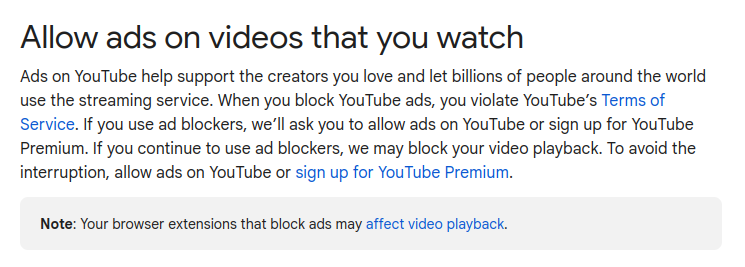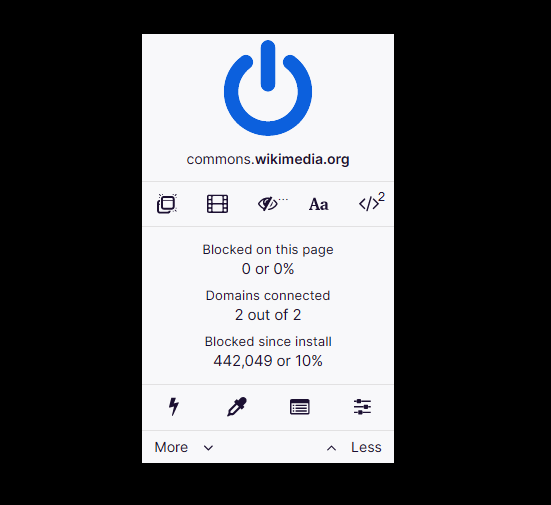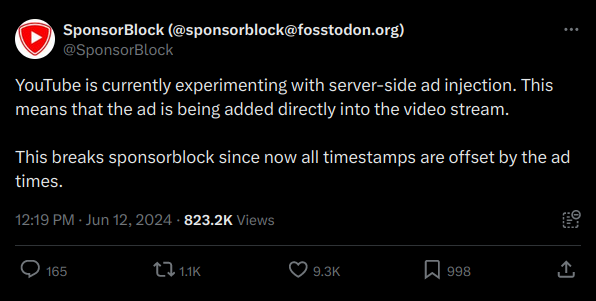YouTube will stop ad blockers by merging ads into videos on the server-side
In their on-going fight against ad blocking technologies, Google plans to begin merging ads into YouTube videos before they leave the server.
It’s all down to the business model
One of the biggest websites in existence, YouTube, is completely free to use - both for posting videos and for watching them. YouTube doesn’t require subscription fees and even with the recently introduced YouTube Premium, the majority of its profits come from, guess where? Advertisements!
Those annoying increasingly unskippable video ads in between your desired content are a major driving source for YouTube’s overall revenue. Despite providing the largest video sharing site on the web, YouTube’s primary product isn’t videos. Even from their earliest stages, YouTube focused on making the consumption of advertisements more palatable by sandwiching them between videos that you are actually interested in watching.
This practice has gone from tolerable to downright unbearable with ads now being unskippable and videos failing to load entirely if Google detects that you are running an adblocker. Google pushes you to digest more and more ads to drive revenue, but by doing so they are adding to the ongoing trend that the ad-based business model is dying. The reason is simple: The more ads you must watch, the less you enjoy browsing through YouTube – or any other free service that uses the same business model.
How to turn off Youtube’s AI-powered age verification
YouTube’s rise and popularity
YouTube hit the internet in 2005 and was bought out by Google towards the end of 2006, fulfilling the dream of most US tech start ups of being eaten by the larger fish. From the beginning, so pre-Google times, the business model of YouTube was to monetize user videos as a means of advertising. Are you looking for the latest viral video? You’ll need to sit through a 10 second ad for bunion cream. By placing the ads immediately before the desired content YouTube is holding your attention and interest hostage.
While in the beginning, YouTube allowed users to skip the ads after a few seconds – particularly if they were logged in to Google so that Google at least could track your entire watching history -, this practice have come to an end. Skipping ads is largely not possible on YouTube anymore.
Annoyed internet users were quick to search for alternatives as they did not want to be forced to watch hours of YouTube advertisements yearly and the demand for ad-blockers boomed. Continuing the tradition of ad-based revenue like with their Gmail product, Google pushed back. This was the beginning of an on-going fight between Google and the developers of different ad blocking technologies.
YouTube’s past with ads and adblockers
As YouTube exploded into global culture, becoming the major video platform worldwide and reaching peak uploads of over 500 hours of new video per minute, the possibilities of monetizing advertisements was massive. In 2012 YouTube’s revenue was estimated to be around $3.7 billion USD, the following year reaching new heights with a disputed claim of $5.6 billion USD.


Google’s official statement on the use of adblockers.
Advertisements are the golden goose of all Google products and YouTube is no different. With ads running before a video begins and again at the end, alongside ad breaks in monetized videos, trying to watch a three minute video for a recipe can turn into a frustrating ordeal. Users who were fed up have flocked to front-ends or ad block extensions in order to avoid ads entirely, but Google isn’t too happy about people failing to pay the piper.
YouTube and AdBlock
There are a number of popular ad blocking browser extensions available with some estimates stating over 1 in 4 internet users in the United States are taking advantage of some form of an ad blocker. Two of the most popular are uBlock Origin and Adblock Plus.


uBlock Origin is one of the world’s most popular adblockers.
In 2023, Google stepped things up and in their “Manifest V3” changes to an API commonly used by adblockers in the Chrome browser reducing the general effectiveness of ad blockers. The move to protect their profit margins by making it harder for Chrome users to avoid ads was not well received by the community and has raised questions about their status as an unavoidable monopoly within the internet ecosystem.
It is understandable that they want to profit, but Google has managed to build the internet around themselves, making them an irremovable cancer to a free and open internet. Google’s core position is not only a clear example of an abusive monopoly, but this move towards centralization is also dangerous for the overall security of the internet as it creates an unavoidable system of gatekeepers and should a major security incident hit that central hub, the consequences could me massive.
Alternative front-ends
There are multiple ways to block ad on YouTube, the most popular being browser extensions, but you could also watch YouTube videos via alternative front-ends like PeerTube or Invidious – which Google also has an eye on. Last year Google has penned a cease and desist letter to Invidious, a front-end project which doesn’t display their ads, while still offering viewers access to videos hosted on the platform. As an open source project, of course Invidious would not have the funding to face off with a tech giant like Google, but the developers and supporters of an ad-free internet are difficult to deter and you can still use any of their free online instances.
Other privacy oriented companies are also starting to offer similar front-end services to allow you to stay private and avoid ads. The DuckDuckGo browser and search engine, for instance, has been offering Duck Viewer as a means of spending less time watching annoying ads.
YouTube and Server-Side Ad Injection
Their latest push in their continuing fight against adblockers is the experiment to begin injecting ads into videos on the server side. This requires a bit of unpacking.


The ad blocker SponsorBlock publishes the news on Google’s server-side ad experiment.
Currently, YouTube videos are delivered from Google’s servers and are then combined with ad sources locally in your browser or in your YouTube-viewing app of choice. The new tactic will blend different segments of advertisements into video before it leaves their servers to be viewed on a user’s end device. This interweaving of ad and video will make it harder for ad blockers to locate the start and endpoints of ads, which will decrease the effectiveness of adblockers as a whole.
Ad-haters aren’t taking this sitting down, and it will be interesting to see the future workarounds developed in this seemingly never ending game of cat-and-mouse.
Ad-free tech is not only possible, but preferred.
It’s not likely that anyone you ask particularly enjoys watching ads, at best there might be an exhausted acceptance of their presence. But there is hope for a better internet!
Privacy oriented companies have realized that there is another way to bring technology to the masses. By actually building a product people are willing to pay for, there is no need to resort to pushing increasingly targeted ads at users. At Tuta we are doing precisely this.
By building a privacy-respecting service with both free and paid subscription models, we are leading the way forward in offering a fully-functional service without selling any user data. Tech doesn’t need to be predatory, start using services which care about you the user!
Signup for a free Tuta Mail account today and take your privacy back!
